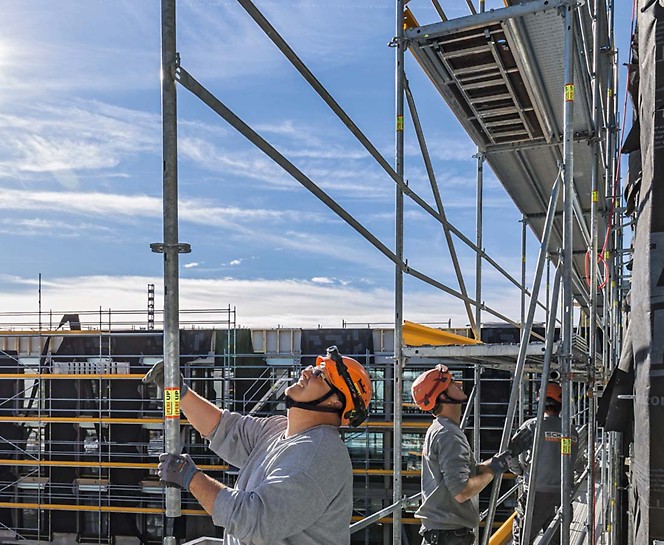Dependable Domestic Scaffolding for Homeowners in Need of Safe Renovations
Discovering the Numerous Sorts Of Scaffolding Made Use Of in Building Projects
The construction sector depends greatly on numerous types of scaffolding to meet specific project needs, each offering distinctive benefits and applications. Standard structure scaffolding provides a sturdy foundation for general jobs, while put on hold scaffolding is essential for job on high-rise frameworks.

Standard Structure Scaffolding
Typical frame scaffolding is among one of the most extensively made use of methods in the building and construction market as a result of its effectiveness and versatility. This system is composed of upright and straight structures that are put together to produce a stable platform for employees and materials. The major elements consist of upright messages, straight ledgers, and diagonal braces, which together provide a strong structure that can sustain substantial loads.
One of the vital benefits of standard framework scaffolding is its adaptability to different building tasks, varying from residential buildings to big commercial frameworks. The modular layout permits for easy setting up and disassembly, making it effective for both lasting and temporary tasks. Additionally, the system can be personalized in height and size, fitting various building designs and website problems.
Safety is extremely important in scaffolding applications, and standard structure systems are outfitted with guardrails and toe boards to avoid falls and ensure worker security. Regular assessments and adherence to safety guidelines are vital in keeping the integrity of the scaffold (Scaffolding). Overall, standard framework scaffolding stays a fundamental choice in the construction sector, giving a reliable platform for labor and improving general job efficiency

Suspended Scaffolding
Suspended scaffolding uses a special remedy for building tasks that call for access to elevated surface areas, particularly in circumstances where typical structure scaffolding might be unwise. This kind of scaffolding is usually suspended from the roof covering or top degrees of a framework, utilizing a system of pulleys, ropes, and platforms to create a functioning area that can be adapted to various heights.
One of the main advantages of put on hold scaffolding is its versatility. It can be easily rearranged or decreased to fit adjustments in building demands, making it ideal for tasks such as home window setup, façade job, and maintenance on high-rise structures. Furthermore, the very little footprint of suspended scaffolding permits for far better use ground space in urban atmospheres, where area is often minimal.
Security is an essential factor to consider in the use of suspended scaffolding. Overall, put on hold scaffolding gives a reliable and effective remedy for accessing hard-to-reach locations in different building and construction circumstances, improving both performance and safety on site.
System Scaffolding
System scaffolding, usually considered as a contemporary option in the scaffolding market, contains pre-engineered elements that can be promptly set up and adapted for different building tasks. Scaffolding. This sort of scaffolding is characterized by its modular style, which enables convenience and efficiency on job websites, accommodating different elevations and structural demands
Generally made from high-strength steel or light weight aluminum, system scaffolding supplies improved toughness and stability. The elements include vertical messages, horizontal journals, and angled braces, which interconnect securely, making certain a robust structure. The design usually incorporates standardized fittings, simplifying setting up and disassembly processes, therefore reducing labor time and expenses.

Rolling Scaffolding
Moving scaffolding is a functional alternative to conventional fixed scaffolding, made for movement and simplicity of usage on construction sites. This kind of scaffolding contains a platform supported by frameworks with wheels, allowing employees to conveniently move it as required. The wheelchair function significantly boosts performance, as it reduces downtime connected with setting up and taking apart dealt with scaffolding.
Typically created from lightweight products such as aluminum or steel, rolling scaffolding supplies a strong yet mobile option for tasks needing frequent repositioning - Scaffolding. It is specifically advantageous in jobs such as paint, drywall installment, and electric job, where accessibility to different elevations and places is required
Safety is vital in rolling scaffolding layout, with attributes such as securing wheels to prevent unintentional activity when in operation, and guardrails to safeguard workers from falls. Additionally, lots of designs are flexible in height, fitting numerous project requirements.
Cantilever Scaffolding

The layout of cantilever scaffolding commonly includes using arms or brackets anchored to a building or framework, enabling the platform to extend external safely. Safety is extremely important; thus, these scaffolds need to be engineered to withstand ecological problems and different loads. Regular evaluation and maintenance are vital to make sure structural stability and worker safety.
Cantilever scaffolding is preferred for its flexibility and effective use area, making it a popular option in city settings where area constraints prevail. In addition, it assists in much easier accessibility to high elevations, inevitably contributing to the general effectiveness of construction projects. Just like all scaffolding kinds, proper training and adherence to security standards are important for workers using cantilever scaffolding.
Conclusion
Traditional framework scaffolding offers stability, while put on hold scaffolding uses versatility for raised tasks. System scaffolding promotes quick assembly, and rolling scaffolding improves movement for varying work environments.
Typical structure scaffolding supplies a sturdy foundation for basic tasks, while put on hold scaffolding is necessary for job on skyscraper structures.Moving scaffolding is a functional alternative to traditional fixed scaffolding, designed for movement and simplicity of use on building websites. As with all scaffolding types, proper training and adherence to safety and security standards are essential for employees making use of cantilever scaffolding.
Traditional frame scaffolding supplies straight from the source stability, while put on hold scaffolding provides versatility for raised jobs. System scaffolding facilitates fast setting up, and rolling scaffolding improves movement for differing work environments.